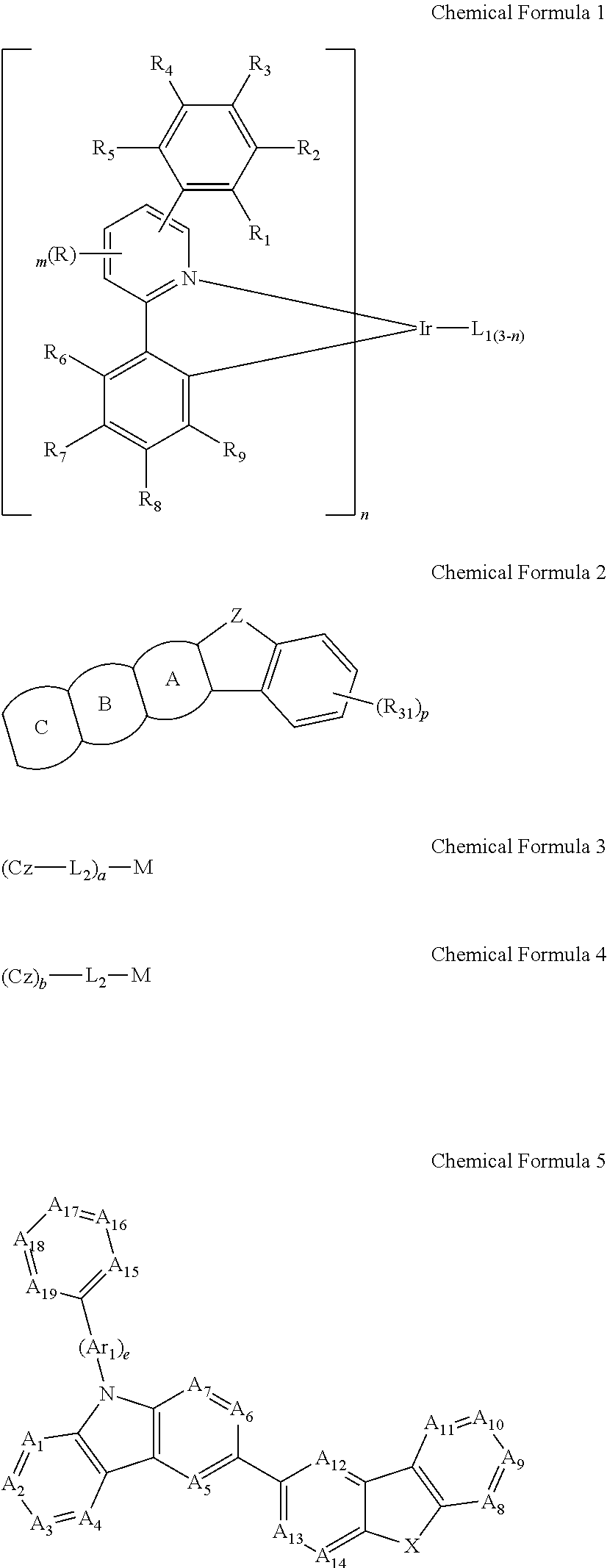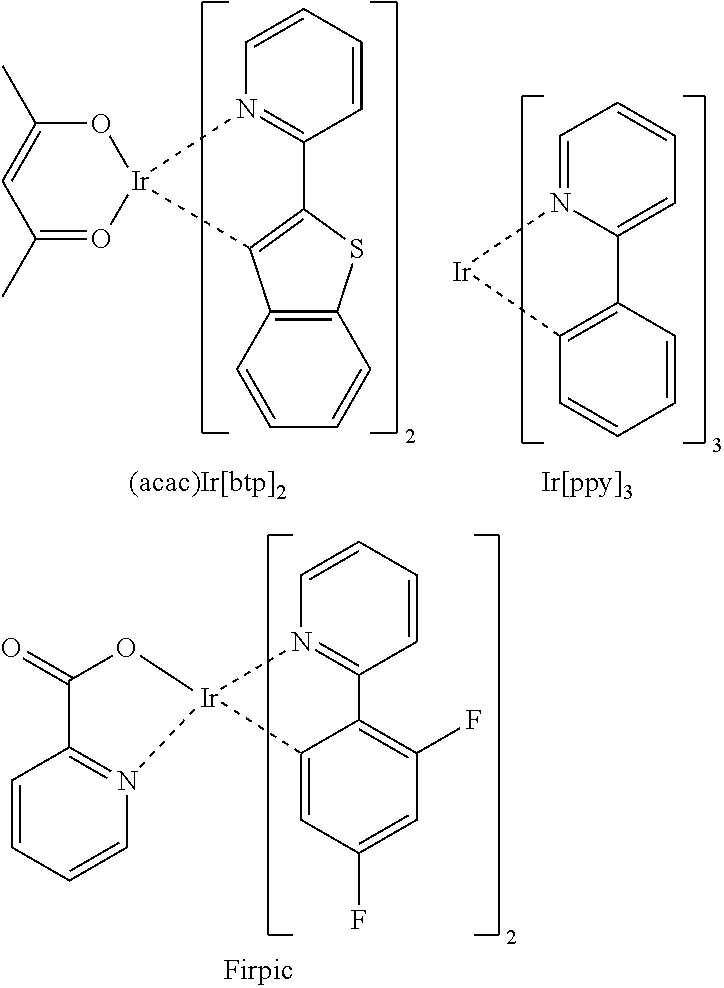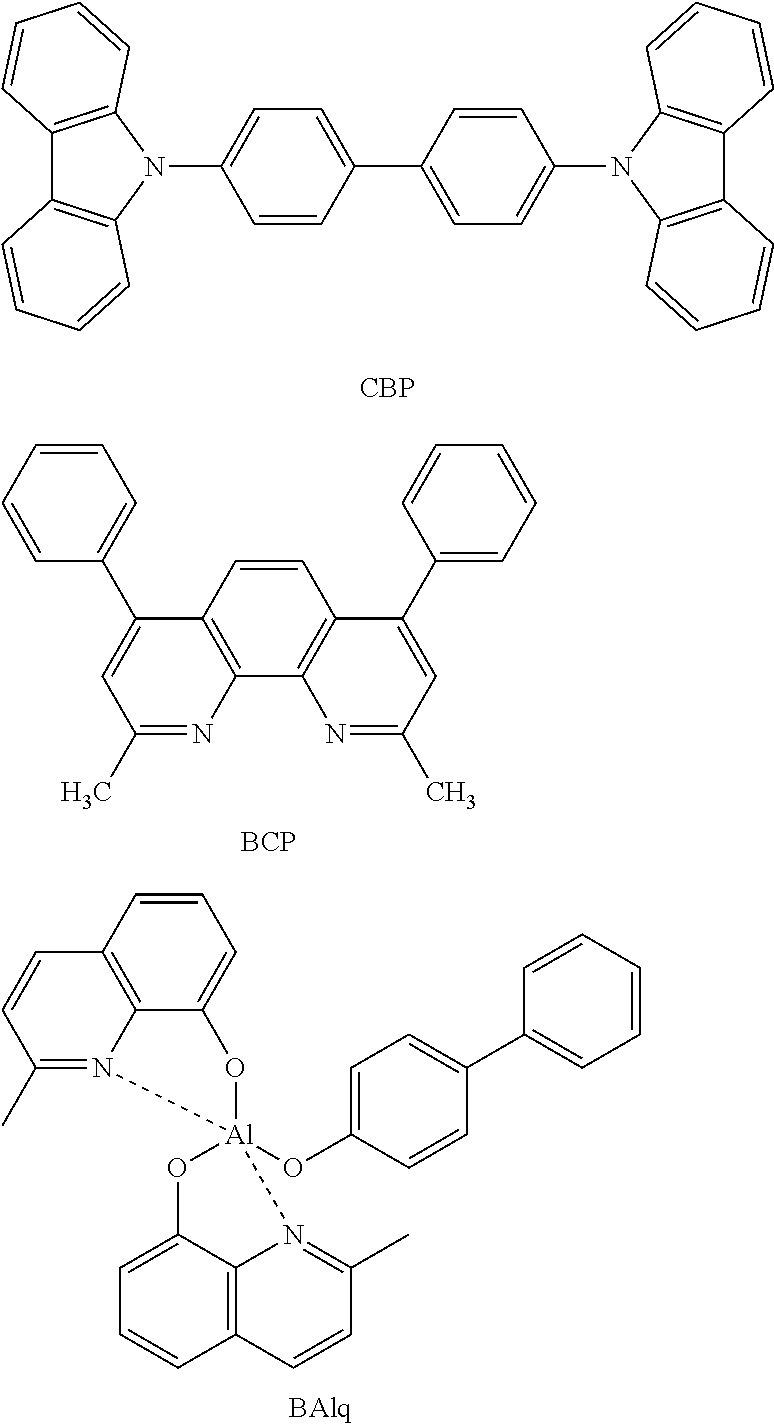Electroluminescent device using electroluminescent compound as luminescent material
a technology of electroluminescent compound and luminescent material, which is applied in the direction of platinum group organic compound, energy-saving lighting, sustainable buildings, etc., can solve the problems of large advantages in view of power efficiency (lm/w), and achieve the effects of reducing driving voltage, improving luminous efficiency, and prolonging operation li
- Summary
- Abstract
- Description
- Claims
- Application Information
AI Technical Summary
Benefits of technology
Problems solved by technology
Method used
Image
Examples
preparation example 2
Preparation of Compound 8
[0122]
Preparation of Compound 2-1
[0123]2,5-dibromopyridine 5 g (21 mmol) was treated in the same manner as the preparation method of Preparation Example 1 for Compound 1-1, thereby obtaining Compound 2-1 4 g (17 mmol).
Preparation of Compound 2-2
[0124]Compound 2-1 4 g (17 mmol), o-tolylboronic acid 2.8 g (20 mmol), and Pd(PPh3)41 g (0.9 mmol) were dissolved in toluene 80 mL, ethanol 40 mL, and 2M Na2CO3 40 mL in the presence of nitrogen, and then stirred under reflux at 120° C. Upon completion of the reaction after 2 hours, the resultant material was washed with distilled water, and extracted with ethyl acetate. The organic layer was dried over MgSO4 and the solvent was removed by a rotary evaporator, followed by purification using column chromatography, thereby obtaining Compound 2-2 (4 g, 15 mmol).
Preparation of Compound 2-3
[0125]2-Bromopyridine 5 g (21 mmol) was treated in the same manner as the preparation method of Preparation Example 1 for Compound 1-1,...
preparation example 3
Preparation of Compound 10
[0129]
Preparation of Compound 3-1
[0130]2.5-Dibromopyridine 5 g (21 mmol) was treated in the same manner as the preparation method of Preparation Example 1 for Compound 1-1, thereby obtaining Compound 3-1 2.6 g (11 mmol).
Preparation of Compound 3-2
[0131]Compound 3-1 2.6 g (11 mmol), d5-phenyl boronic acid 1.8 g (13 mmol), and Pd(PPh3)4 0.7 g (0.6 mmol) were dissolved in toluene 40 mL, ethanol 20 mL, and 2M Na2CO3 20 mL in the presence of nitrogen, and then stirred under reflux at 120° C. Upon completion of the reaction after 2 hours, the resultant material was washed with distilled water, and extracted with ethyl acetate. The organic layer was dried over MgSO4 and the solvent was removed by a rotary evaporator, followed by purification using column chromatography, thereby obtaining Compound 3-2 (2.2 g, 9.3 mmol).
Preparation of Compound 3-3
[0132]Compound 3-2 2.2 g (9.3 mmol), iridium chloride (IrCl3) 1.1 g (4.2 mmol), 2-ethoxyethanol 45 mL, and distilled wate...
preparation example 4
Preparation of Compound 20
[0136]
Preparation of Compound 4-1
[0137]2,5-Dibromo-4-methylpyridine 5 g (21 mmol) was treated in the same manner as the preparation method of Preparation Example 1 for Compound 1-1, thereby obtaining Compound 4-1 4 g (17 mmol).
Preparation of Compound 4-2
[0138]Compound 4-1 4 g (17 mmol), 4-fluorophenylboronic acid 2.8 g (20 mmol), and Pd(PPh3)41 g (0.9 mmol) were dissolved in toluene 80 mL, ethanol 40 mL, and 2M Na2CO3 40 mL in the presence of nitrogen, and then stirred under reflux at 120° C. Upon completion of the reaction after 2 hours, the resultant material was washed with distilled water, and extracted with ethyl acetate. The organic layer was dried over MgSO4 and the solvent was removed by a rotary evaporator, followed by purification using column chromatography, thereby obtaining Compound 4-2 (4 g, 15 mmol).
Preparation of Compound 4-3
[0139]Compound 4-2 4 g (15 mmol), iridium chloride (IrCl3) 2 g (6.8 mmol), 2-ethoxyethanol 90 mL, and distilled water ...
PUM
| Property | Measurement | Unit |
|---|---|---|
| electroluminescent | aaaaa | aaaaa |
| time | aaaaa | aaaaa |
| Chemical | aaaaa | aaaaa |
Abstract
Description
Claims
Application Information
 Login to View More
Login to View More - R&D
- Intellectual Property
- Life Sciences
- Materials
- Tech Scout
- Unparalleled Data Quality
- Higher Quality Content
- 60% Fewer Hallucinations
Browse by: Latest US Patents, China's latest patents, Technical Efficacy Thesaurus, Application Domain, Technology Topic, Popular Technical Reports.
© 2025 PatSnap. All rights reserved.Legal|Privacy policy|Modern Slavery Act Transparency Statement|Sitemap|About US| Contact US: help@patsnap.com



